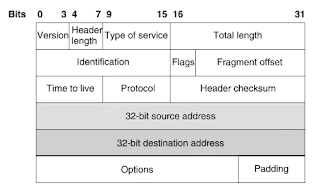IPV4 Header
The IPv4 datagram is conceptually divided into two pieces: the header and the payload. The header contains addressing and control fields, while the payload carries the actual data to be sent over the internetwork. The header consists of 10 basic header fields.
IPV6 Header
IPv6 contain 6 basic header fields.
IPv6 header has 40 octets in contrast to the 20 octets in IPv4 So a smaller number of header fields and the header is 64-bit.
Aligned to enable fast processing by current processors.
The IPv6 header fields:
• Version:
A 4-bit field, same as in IPv4. It contains the number 6 instead of the number 4 for IPv4.
• Traffic class:
A 8-bit field similar to the type of service (ToS) field in IPv4. It tags packet with a traffic class that it uses in differentiated services (DiffServ). These functionalities are the same for IPv6 and IPv4.
• Flow label:
A completely new 20-bit field. It tags a flow for the IP packets. It can be used for multilayer switching techniques and faster packet-switching performance.
• Payload length:
This 16-bit field is similar to the IPv4 Total Length Field, except that with IPv6 the Payload Length
field is the length of the data carried after the header, whereas with IPv4 the Total Length Field
included the header. 216 = 65536 Octets.
• Next header:
The 8-bit value of this field determines the type of information that follows the basic IPv6 header. It
can be a transport-layer packet, such as TCP or UDP, or it can be an extension header. The next
header field is similar to the protocol field of IPv4.
• Hop limit:
This 8-bit field defines by a number which count the maximum hops that a packet can remain in the
network before it is destroyed. With the IPv4 TLV field this was expressed in seconds and was
typically a theoretical value and not very easy to estimate.
Do you know about IPV6 Extension Header ???
Adding an optional Extension Header in IPv6 makes it simple to add new features in IP protocol in future without a major reengineering of IP routers everywhere.
The number of extension headers are not fixed, so the total length of the extension header chain is variable.
The extension header will be placed in-between main header and payload in IPv6 packet.
Adding an optional Extension Header in IPv6 makes it simple to add new features in IP protocol in future without a major reengineering of IP routers everywhere.
If the Next Header field value (code) is 6 it determine that there is no extension header and the next header field is pointing to TCP header which is the payload of this IPv6 packet.
Code values of Next Header field:
0 Hop-by-hope option
2 ICMP
6 TCP
17 UDP
43 Source routing
44 Fragmentation
50 Encrypted security payload
51 Authentication
59 Null (No next header)
60 Destination option


No comments:
Post a Comment